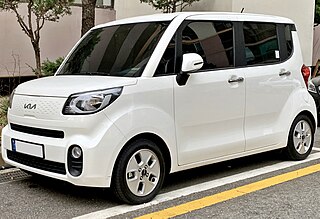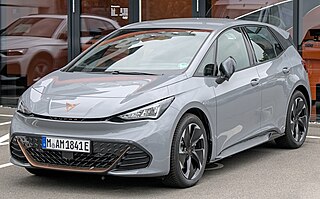
The Volkswagen Up is a city car produced by the Volkswagen Group from 2011 to 2023. It was unveiled at the 2011 International Motor Show Germany (IAA). Production of the Up started with the model year of 2012, in December 2011 at the Volkswagen Plant in Bratislava, Slovakia. It is part of the New Small Family (NSF) series of models, alongside the SEAT Mii and Škoda Citigo which are rebadged versions of the Up, with slightly different front and rear fascias. The SEAT and Škoda versions were manufactured in the same factory, before being withdrawn from sale in 2021 and 2020 respectively. Production of the Up ended in October 2023. A battery electric version, called E-up, was launched in autumn 2013.
Toyota concept vehicles are transportation devices manufactured or designed by automobile company Toyota from 2000 to 2009. As their name suggests, these vehicles were concepts, and, as such, many were never released to dealerships. Many were developed in conjunction with other corporations such as Sony or Subaru.
Toyota Concept Vehicles produced between 2010 and 2019 include:

The Kia Ray is a city car manufactured by Kia exclusively for the South Korean domestic market. Based on the Kia Picanto/Morning, it was specifically developed in compliance with the "light car" category that offers tax incentives for cars with exterior dimensions below 3,600 mm (141.7 in) in length and below 1,600 mm (63.0 in) in width. This is a Korean-only vehicle.

The Kia Niro is a subcompact crossover SUV (B-segment) manufactured by Kia since 2016. It is an electrification-focused vehicle, offering three versions: hybrid, plug-in hybrid and battery electric variants.

The Porsche Taycan is a battery electric luxury sports sedan and shooting brake car produced by German automobile manufacturer Porsche. The concept version of the Taycan named the Porsche Mission E, debuted at the 2015 Frankfurt Motor Show. Four years later, the production Taycan was revealed at the 2019 Frankfurt Motor Show. As Porsche's first series production electric car, it is sold in several variants at different performance levels, and may spawn further derivatives in future models. It is built on the J1 electric car platform shared with the similarly shaped Audi e-tron GT.

Karma Automotive is a privately owned American luxury electric vehicle company founded in 2014 and now owned by Chinese conglomerate Wanxiang Group. Headquartered in Irvine, California with an assembly plant located in Moreno Valley, Karma sells vehicles via its dealer network of locations in North America, Europe, South America, and the Middle East.

The Hyundai Kona is a subcompact crossover SUV produced by the South Korean manufacturer Hyundai. The first-generation Kona debuted in June 2017 and the production version was revealed later that year. It is positioned between the Venue or Bayon and the Tucson in Hyundai crossover SUV line-up. The battery electric version called the Kona Electric was first launched in South Korea during the first half of 2018 and rolled out gradually worldwide afterwards.
The Honda EV Concept vehicles are a series of two concept electric cars created by the automobile division of Honda, designed with cues to historical Honda products. The Urban EV Concept made its debut at the 2017 International Motor Show Germany in September 2017, while the Sports EV Concept debuted at the Tokyo Motor Show a month later.

The BMW i4 is a battery electric compact executive car produced by BMW since 2021. It has a five-door liftback body style and is marketed as a four-door coupé. The initial concept version, named BMW i Vision Dynamics, debuted at the 2017 Frankfurt Motor Show. It is the fifth BMW i sub-brand model, and is sold in several variants at different performance levels, including the first battery-electric variant by BMW's motorsport division. The production version was revealed in March 2021 and went on sale in November of the same year as a 2022 model.

The Honda e is an battery electric car that was manufactured by Japanese automaker Honda and sold in Japan from 2020 to 2024 and in Europe from 2020 to 2023. It is a supermini with a five-door hatchback design and a battery-electric powertrain that drives the rear wheels. The vehicle is styled with a retro look reminiscent of the first-generation Civic. It was previewed by the 2017 Urban EV Concept with the production version first shown publicly in 2019.

The Mazda MX-30 is a subcompact crossover SUV produced by Mazda and sold as a battery electric (BEV), plug-in hybrid (PHEV) or mild hybrid (MHEV) variant. Based on the CX-30, it was unveiled at the 2019 Tokyo Motor Show. Production of the vehicle, which is Mazda's first mass-produced electric car, began at their Ujina factory on 19 May 2020.

The Cupra Born is a battery electric compact car/small family car (C-segment) marketed by SEAT through its performance-oriented Cupra marque. Initially unveiled as the SEAT el-Born concept in 2019, the production car was revealed in May 2021 as the Cupra Born. The Born is based on the Volkswagen Group MEB platform and has been manufactured at the same plant in Zwickau, Germany, as the MEB-based Volkswagen ID.3. The car is named after a neighbourhood in Barcelona, Catalonia, Spain.
Ioniq is an automotive sub-brand and a division of Hyundai Motor Company with headquarters in Seoul, South Korea. The sub-brand was established in 2020 as a sub-brand for Hyundai's electric vehicle line-up. The sub-brand is slated to aid Hyundai to achieve a targeted 1 million electric vehicle sales annually by 2025, with the Ioniq brand projected to contribute 560,000 of those sales.

The Hyundai Ioniq 5 is a battery electric compact crossover SUV produced by Hyundai since 2021. It is the first product to be marketed under the electric cars-focused Ioniq sub-brand, and the first model developed on the Hyundai Electric Global Modular Platform (E-GMP).

The Hyundai Ioniq 6 is a battery electric mid-size fastback sedan produced by Hyundai Motor Company. It is the second vehicle marketed under the electric car-focused Ioniq sub-brand after the Ioniq 5, and the fourth model developed on the Hyundai Electric Global Modular Platform (E-GMP). The vehicle was first sold in South Korea in late 2022, with deliveries in the United States beginning in March 2023.

The Renault 5 E-Tech is a B-segment battery electric car by French manufacturer Renault that will begin production in 2024. Inspired by the original Renault 5 in styling, the 5 E-Tech was previewed by a concept car shown in January 2021, with the production model being officially unveiled at the Geneva International Motor Show in February 2024.

The Kia Naimo was an electric subcompact crossover SUV concept revealed by South Korean automobile manufacturer Kia at the 2011 Seoul Motor Show.

The Kia EV9 is an battery electric mid-size crossover SUV produced by Kia. It is the second Kia model developed on the Electric Global Modular Platform (E-GMP) and the second model in the manufacturer's "EV" electric car range after the EV6.

The Mercedes-Benz Vision EQXX is a battery electric concept car by German carmaker Mercedes-Benz. Unveiled at the 2022 edition of the Consumer Electronics Show as part of the Mercedes-EQ series, it is a proof of concept, with Mercedes-Benz's primary goal being a target of below 10 kWh per 100 km in real-life conditions. The EQXX's exterior features various stylistic cues that help maximise its aerodynamic efficiency, and numerous eco-friendly materials that adorn the interior. The car's name refers to Mercedes' vision for the future of automobile manufacturing, with Mercedes chairman Ola Källenius stating that the EQXX is "how we imagine the future of electric cars", and that the car "underlines where our entire company is headed".















